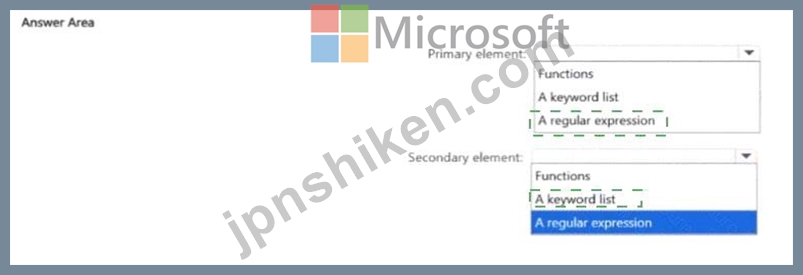- ホーム
- Microsoft
- SC-401J - Administering Information Security in Microsoft 365(SC-401日本語版)
- Microsoft.SC-401J.v2025-09-22.q67
- 質問42
有効的なSC-401J問題集はJPNTest.com提供され、SC-401J試験に合格することに役に立ちます!JPNTest.comは今最新SC-401J試験問題集を提供します。JPNTest.com SC-401J試験問題集はもう更新されました。ここでSC-401J問題集のテストエンジンを手に入れます。
SC-401J問題集最新版のアクセス
「165問、30% ディスカウント、特別な割引コード:JPNshiken」
Microsoft 365 テナントをお持ちの場合
次の内容を含むアイテムに対して、新しい機密タイプを作成する必要があります。
* 従業員の雇用日とそれに続く3桁の数字で構成される従業員ID番号
* 従業員ID番号の300文字以内に「従業員」、「ID」、または「識別」という単語を含める。主要素と副要素には何を使用すればよいですか?回答するには、回答エリアで適切なオプションを選択してください。注:正しい選択ごとに1ポイントが加算されます。

次の内容を含むアイテムに対して、新しい機密タイプを作成する必要があります。
* 従業員の雇用日とそれに続く3桁の数字で構成される従業員ID番号
* 従業員ID番号の300文字以内に「従業員」、「ID」、または「識別」という単語を含める。主要素と副要素には何を使用すればよいですか?回答するには、回答エリアで適切なオプションを選択してください。注:正しい選択ごとに1ポイントが加算されます。

正解:

Explanation:

Step 1 - Requirement
We need a custom sensitive information type (SIT) that detects:
An employee ID number in a specific format # hire date + three digits.
This is a pattern-based requirement.
Specific keywords within 300 characters of that ID # "Employee", "ID", or "Identification".
This is a keyword proximity requirement.
Step 2 - Sensitive info type elements in Microsoft 365
When creating custom SITs, you define primary and secondary elements:
Primary element # The main pattern or data to detect (the most defining factor).
Secondary element # Supporting evidence that must be found near the primary element to increase confidence.
Available elements:
Regular expression # Used to define patterns such as date + digits (for employee ID).
Keyword list # Used for lists of words/phrases like "Employee", "ID", "Identification".
Functions # Used for built-in validators like credit card checksum, not relevant here.
# Reference: Create a custom sensitive information type in Microsoft 365 Step 3 - Apply to scenario Employee ID pattern (hire date + 3 digits) # Needs a regular expression # This must be the Primary element.
Keywords ("Employee", "ID", "Identification") within 300 characters # A keyword list # This must be the Secondary element.
- 質問一覧「67問」
- 質問1 次の表に示すファイルがあります。 (Exhibit) 展示に示されてい...
- 質問2 Site1 という Microsoft SharePoint Online サイトがあり、そこ...
- 質問3 Microsoft 365 E5 サブスクリプションがあり、User1 というユー...
- 質問4 Site1とSite2という2つのMicrosoft SharePoint Onlineサイトを含...
- 質問5 次の場所から 7 年後にコンテンツを削除するには、保持ポリシー...
- 質問6 ホットスポット Microsoft 365 サブスクリプションをお持ちです...
- 質問7 Site1 という名前の Microsoft SharePoint Online サイトを含む ...
- 質問8 Microsoft 365 ES サブスクリプションをお持ちです。 セキュリテ...
- 質問9 Microsoft 365 E5 サブスクリプションがあり、そこには User1、U...
- 質問10 ドラッグ&ドロップ 20 個のデータ損失防止 (DLP) ポリシーが含...
- 質問11 Microsoft 365 E5 サブスクリプションをお持ちです。 データ損失...
- 質問12 ドラッグ&ドロップ 自動適用保持ラベル ポリシーの条件として使...
- 質問13 Microsoft 36S ES サブスクリプションをお持ちです。 Microsoft ...
- 質問14 ユーザーにMicrosoft Purviewポータルでデータ損失防止(DIP)ア...
- 質問15 Microsoft 36S ES サブスクリプションをお持ちです EDM1 という...
- 質問16 Microsoft 365 E5 サブスクリプションをお持ちです。 Microsoft ...
- 質問17 注: この問題は、同じシナリオを提示する一連の問題の一部です。...
- 質問18 Microsoft Purview を使用する Microsoft 365 E5 サブスクリプシ...
- 質問19 Microsoft 565 E5 サブスクリプションをお持ちです。 Microsoft ...
- 質問20 Microsoft 36S ES サブスクリプションをお持ちです 次の要件を満...
- 質問21 Microsoft 365 E5 サブスクリプションをお持ちです。 ユーザーが...
- 質問22 EDM1 という名前の Microsoft Purview 完全データ一致 (EDM) 分...
- 質問23 Microsoft 36S ES サブスクリプションをお持ちです。 Microsoft ...
- 質問24 Microsoft 365 サブスクリプションをお持ちです。監査が有効にな...
- 質問25 注: この問題は、同じシナリオを提示する一連の問題の一部です。...
- 質問26 Microsoft 365 ES サブスクリプションをお持ちです。 Microsoft ...
- 質問27 トレーニング可能な分類子をオプトインする Microsoft 365 テナ...
- 質問28 Microsoft 36S ES サブスクリプションには、Devicel1 と Device2...
- 質問29 Microsoft Purview を使用する Microsoft 365 E5 サブスクリプシ...
- 質問30 ホットスポット Microsoft Purview とジャストインタイム (JIT) ...
- 質問31 あなたの会社は複数の国にオフィスを持っています。 同社では、M...
- 質問32 ホットスポット 次の表に示すユーザーを含む Microsoft 365 E5 ...
- 質問33 Microsoft 365 E5 サブスクリプションをお持ちです。 プロジェク...
- 質問34 User1 という名前のユーザーを含む Microsoft J65 E5 サブスクリ...
- 質問35 ホットスポット SharePoint Online 環境のポリシーを確認してい...
- 質問36 ユーザーが Microsoft OneDrive から社外のユーザーと機密文書を...
- 質問37 Microsoft 365 サブスクリプションをお持ちです。 ユーザーは Wi...
- 質問38 Trainable1 という名前のトレーニング可能な分類子を含む Micros...
- 質問39 Microsoft 365 サブスクリプションをお持ちです。 Microsoft Pur...
- 質問40 デバイスの所在地にデータ損失防止(DIP)ポリシーが適用されて...
- 質問41 次の要件を満たすデータ損失防止 (DIP) ポリシーを作成します。 ...
- 質問42 Microsoft 365 テナントをお持ちの場合 次の内容を含むアイテム...
- 質問43 Microsoft 36S エンドポイント データ損失検出イベント モニタリ...
- 質問44 機密ラベルを作成するための技術要件を満たす必要があります。
- 質問45 Microsoftで参照される組織の製品コードを識別するためのカスタ...
- 質問46 Microsoft S65 E5 サブスクリプションがあり、そこには User! と...
- 質問47 Contoso と Fabrikam という2つの Microsoft 365 サブスクリプシ...
- 質問48 次のラベルを含む Contoso_Policy という名前の保持ラベル ポリ...
- 質問49 Microsoft Purview Message Encryption を使用する Microsoft 36...
- 質問50 Microsoft 365 サブスクリプションをお持ちです。 User1 という...
- 質問51 社内でMicrosoft Purview Advanced Message Encryptionの機能を...
- 質問52 注: この問題は、同じシナリオを提示する一連の問題の一部です。...
- 質問53 次の表に示すデバイスが含まれる Microsoft 36S ES サブスクリプ...
- 質問54 次の表に示すデバイスが含まれる Microsoft 36S ES サブスクリプ...
- 質問55 Microsoft 365 E5 サブスクリプションをお持ちです。 Microsoft ...
- 質問56 プロジェクトの終了時に、多数のファイルを含むMicrosoft ShareP...
- 質問57 contoso.com という名前のドメインを使用する Microsoft 365 E5 ...
- 質問58 注: この問題は、同じシナリオを提示する一連の問題の一部です。...
- 質問59 User1 という名前のユーザーを含む Microsoft 365 E5 サブスクリ...
- 質問60 Microsoft 365 エンドポイント データ損失防止 (エンドポイント ...
- 質問61 Microsoft 365 サブスクリプションをお持ちです。 新しいトレー...
- 質問62 次の表に示すグループを含む Microsoft 365 E5 サブスクリプショ...
- 質問63 Site1 という名前の Microsoft SharePoint Online サイトがあり...
- 質問64 次の表に示すデバイスが含まれる Microsoft 365 サブスクリプシ...
- 質問65 Microsoft 365 E5 テナントに User1 というユーザーがいます。Us...
- 質問66 Site! という名前の Microsoft SharePoint Online サイトと、次...
- 質問67 次の図に示す機密情報の種類 (SIT) が含まれる Microsoft 36S サ...

